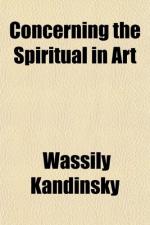In the process of the gradual abandonment of natural form the “angle” school is paralleled by the “curve” school, which also descends wholly from Gauguin. The best known representative is Maurice Denis. But he has become a slave to sentimentality, and has been left behind. Matisse is the most prominent French artist who has followed Gauguin with curves. In Germany a group of young men, who form the Neue Kunstlevereinigung in Munich, work almost entirely in sweeping curves, and have reduced natural objects purely to flowing, decorative units.
But while they have followed Gauguin’s lead in abandoning representation both of these two groups of advance are lacking in spiritual meaning. Their aim becomes more and more decorative, with an undercurrent of suggestion of simplified form. Anyone who has studied Gauguin will be aware of the intense spiritual value of his work. The man is a preacher and a psychologist, universal by his very unorthodoxy, fundamental because he goes deeper than civilization. In his disciples this great element is wanting. Kandinsky has supplied the need. He is not only on the track of an art more purely spiritual than was conceived even by Gauguin, but he has achieved the final abandonment of all representative intention. In this way he combines in himself the spiritual and technical tendencies of one great branch of Post-Impressionism.
The question most generally asked about Kandinsky’s art is: “What is he trying to do?” It is to be hoped that this book will do something towards answering the question. But it will not do everything. This—partly because it is impossible to put into words the whole of Kandinsky’s ideal, partly because in his anxiety to state his case, to court criticism, the author has been tempted to formulate more than is wise. His analysis of colours and their effects on the spectator is not the real basis of his art, because, if it were, one could, with the help of a scientific manual, describe one’s emotions before his pictures with perfect accuracy. And this is impossible.
Kandinsky is painting music. That is to say, he has broken down the barrier between music and painting, and has isolated the pure emotion which, for want of a better name, we call the artistic emotion. Anyone who has listened to good music with any enjoyment will admit to an unmistakable but quite indefinable thrill. He will not be able, with sincerity, to say that such a passage gave him such visual impressions, or such a harmony roused in him such emotions. The effect of music is too subtle for words. And the same with this painting of Kandinsky’s. Speaking for myself, to stand in front of some of his drawings or pictures gives a keener and more spiritual pleasure than any other kind of painting. But I could not express in the least what gives the pleasure. Presumably the lines and colours have the same effect as harmony and rhythm in music have on the truly musical. That psychology comes in no one can deny. Many




